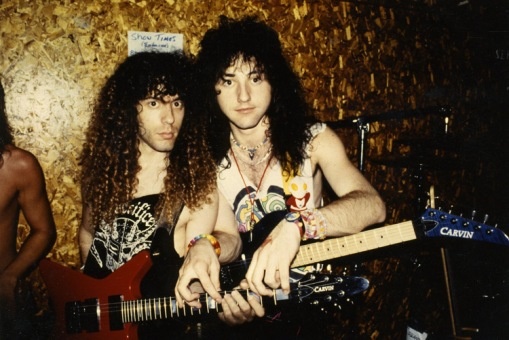Metal is global—but of the many American contributions to the genre, Megadeth is one of the biggest. An incredible talent with a case of wanderlust, Marty Friedman’s story stands as remarkable: a guitarist who left one of metal’s most successful bands at the height of his fame to pursue an entirely different dream on the other side of the world.
What makes Friedman’s journey particularly compelling isn’t simply the geographic distance he traveled, but the cultural one. His transformation from American metal virtuoso to Japanese television personality represents a unique case study in cultural assimilation—one that challenges conventional notions of identity, belonging, and artistic fulfillment. In an age when globalization often feels like cultural homogenization, Friedman’s experience suggests a synthesis of the two: the possibility of genuine cultural integration without the loss of essential self.
Origins
The story begins conventionally enough. Martin Adam Friedman was born December 8, 1962, in Washington, D.C., into what he describes as a typical middle-class Jewish family¹. His musical awakening arrived with the theatrical force that would define much of his career: after attending a KISS concert at fourteen, he picked up the guitar and never looked back. What distinguished him wasn’t natural talent—he was largely self-taught¹—but rather an instinctive understanding that authenticity mattered more than technical perfection.
The early years followed the familiar arc of American rock mythology. There were garage bands with names like Deuce and Hawaii, late-night rehearsals in borrowed spaces, and the gradual realization that music could be more than hobby². The mother of one of Marty’s friends ran an event center with a two-level stage, and Marty and his friends used it as a rehearsal space. Soon word spread about their band, and, since they were in a rural area, people would come from miles around to socialize and listen to music². These informal gatherings taught Friedman something crucial about performance: that the connection between artist and audience transcends language, culture, and expectation.
Yet success didn’t come easily. Before joining Megadeth, Friedman endured what he now describes as periods of genuine hardship—auditions for Madonna, Kiss, and Ozzy Osbourne that went nowhere, stretches of homelessness that tested his commitment to music³. These experiences, humbling and difficult as they were, provided something invaluable: a perspective on success that would later make his dramatic career pivot seem less like abandonment and more like evolution.
A Musical Reckoning
Friedman’s partnership with Jason Becker in Cacophony marked his emergence as a serious musician. The band’s neoclassical metal approach—synchronized twin guitar harmonies and counterpoints²—established him within the technical metal community, but it was the dissolution of Cacophony in 1989 that opened the door to his defining opportunity.

When he auditioned for Megadeth, the initial meeting was unpromising. Dave Mustaine, the band’s mercurial leader, reportedly disliked Friedman’s multicolored hair⁴. But musical chemistry transcended aesthetic preferences, and by February 1990, Friedman had officially joined one of thrash metal’s most important bands¹.
The decade that followed represented the pinnacle of metal success. “Rust in Peace,” his first album with the band, achieved both critical acclaim and commercial success, earning platinum certification and a Grammy nomination¹. The follow-up, “Countdown to Extinction,” went double platinum¹. During Friedman’s tenure, Megadeth sold more than ten million albums worldwide⁵, establishing themselves as part of thrash metal’s “Big Four” alongside Metallica, Slayer, and Anthrax.
Yet even at the height of this success, Friedman felt increasingly constrained. He later described growing tired of “holding the flag” for traditional metal, sensing that continued evolution within the genre’s boundaries would be impossible¹. This artistic restlessness, combined with severe panic attacks during his final months with the band¹, pointed toward a fundamental incompatibility between his creative aspirations and his circumstances.
A Career Unordinary
The decision to leave Megadeth in 1999 puzzled observers and industry insiders alike. Why abandon a platinum-selling band at its commercial peak? The answer lay in Friedman’s growing fascination with Japanese popular music, a interest that had developed quietly during Megadeth’s frequent tours of Japan.
His first encounter with J-pop had been almost accidental. However, I did listen to a singer named Mihara Junko, because one of my guitar students had brought it in to learn. I thought it was very odd that such sugary-sweet-candy-pop music would have so much guitar riffing and guitar soloing in it⁶. This observation—that Japanese pop music incorporated complex musical elements that American pop avoided—suggested possibilities for artistic exploration that American metal couldn’t provide.
The cultural contrast was equally compelling. “It’s like being on another planet,” he said of his first visit to Japan with Cacophony in 1989⁷. You can’t read the signs, you can’t read the menus, you don’t know which bathroom to go into⁶. Rather than finding this disorientation unsettling, Friedman embraced it as creatively stimulating.

By the time he left Megadeth, he had been studying Japanese intensively for several years. “Out of respect for the fans and staff who treated me so well, I wanted to learn the language and I was close to fluent by the time I left Megadeth”³. This linguistic preparation wasn’t casual; it represented a deliberate investment in a future he was already envisioning.
Life in Japan
Friedman’s relocation to Tokyo in 2003 marked the beginning of perhaps the most unlikely second act in rock history. His integration into Japanese culture was facilitated by strategic decisions—joining established J-pop singer Nanase Aikawa’s band provided immediate credibility within the Japanese music industry⁸—but his subsequent television career emerged almost by accident.
The opportunity came through “Hebimeta-San” (Mr. Heavy Metal), a variety show that parodied heavy metal culture while celebrating it⁶. The premise—exposing the secret metal fantasies of unlikely fans—perfectly matched Friedman’s position as cultural ambassador. His participation was initially reluctant, but the show’s success changed everything. What was meant to be a single season became two, then spawned a spinoff called “Rock Fujiyama” that ran for over a year⁹.
The television work snowballed in ways that surprised even Friedman. By his own count, he has appeared on more than 700 Japanese television programs⁵, ranging from music shows to variety programs to political discussions. He became, in the words of one Japanese media executive, something like the “Ryan Seacrest of Japan”⁷—a comparison that captures both his ubiquity and his role as cultural interpreter.

This media career brought unexpected recognition. In 2016, he became a Japanese Heritage Ambassador for the Japanese Government Agency for Cultural Affairs¹⁰, composing the official theme song for Japan Heritage. The appointment represented something remarkable: an American immigrant not just accepted by Japanese society, but trusted to represent it internationally.
Personal life evolved alongside professional success. His marriage to Japanese cellist Hiyori Okuda in 2012¹ symbolized his complete integration into Japanese society, though he maintains that integration has been cultural rather than simply geographical.
On Americanism
Friedman’s relationship with his American identity has deepened rather than diminished through distance. He remains a permanent resident rather than a Japanese citizen, a distinction he considers important. “I feel at home in Japan but as an American it doesn’t necessarily mean that I belong. It’s about coexisting and both sides getting something good out of it”³.
This perspective reflects a sophisticated understanding of cultural identity that transcends simple binaries of belonging. When he visits Los Angeles, he reconnects with family and friends he “misses terribly”³, yet his life in Tokyo feels equally authentic. “Home is where you make it,” he explains, but the statement encompasses complexity rather than simplicity³.
His approach to cultural exchange has been genuinely bidirectional. Japanese audiences value his American perspective on music and culture, while his American identity has been enriched by Japanese influences. A Japanese television executive noted that “Marty is a very good balance between the two cultures…He brings knowledge of the American music scene, of course, because he was in it”⁷.
Perhaps most tellingly, his 2023 reunion with Megadeth at Tokyo’s Budokan demonstrated how his Japanese experience had enhanced rather than replaced his American musical legacy. “The show couldn’t have been any better,” he reflected, “and to be completely honest, the band sounded better than when I was in it”³. The comment suggests not nostalgia but integration—his time in Japan had given him new perspective on his American musical heritage.
Twenty years after leaving American rock stardom for Japanese television, Marty Friedman’s story reads less like exile than like expansion. His journey suggests that cultural identity need not be zero-sum, that embracing foreign cultures can deepen rather than diminish one’s connection to home.
What makes his experience particularly American is precisely his willingness to risk everything for an uncertain dream. The entrepreneurial spirit that built his metal career proved equally valuable in navigating Japanese media culture. His story embodies a kind of cultural entrepreneurship—the recognition that identity itself can be innovated, that belonging can be earned rather than simply inherited.
In our increasingly connected yet polarized world, Friedman’s example offers something valuable: proof that genuine cultural exchange is possible, that an American can become authentically integrated into foreign culture without ceasing to be American. His new home hasn’t replaced his old identity—it has revealed new dimensions of what that identity might contain.
References
- “Marty Friedman – Wikipedia.” Wikipedia. https://en.wikipedia.org/wiki/Marty_Friedman
- “Marty Friedman | Metal Wiki | Fandom.” Metal Wiki. https://metal.fandom.com/wiki/Marty_Friedman
- Lord, Christopher. “From Megadeth to Japanese make-up tutorials: the bizarre life of guitarist Marty Friedman.” The Guardian, May 15, 2024.
- “Marty Friedman – Age, Bio, Personal Life, Family & Stats | CelebsAges.” CelebsAges. https://www.celebsages.com/marty-friedman/
- “Marty Friedman – Wikipedia.” Wikipedia. https://en.wikipedia.org/wiki/Marty_Friedman
- “Marty Friedman Interview, Why He Moved to Japan.” Tofugu. https://www.tofugu.com/interviews/marty-friedman-japan/
- “Marty Friedman: From Megadeth to the ‘Ryan Seacrest Of Japan’ to a Shredding New Album.” Billboard. https://www.billboard.com/pro/marty-friedman-japan-tv-celebrity-megadeth-guitarist-inferno-album/
- “How Megadeth’s Marty Friedman Became a Japanese TV Star.” Rolling Stone. https://www.rollingstone.com/culture/culture-news/life-after-deth-how-megadeths-marty-friedman-became-a-japanese-superstar-71295/2/
- “MARTY FRIEDMAN Explains How He Became A TV Star In Japan – Metal Injection.” Metal Injection. https://metalinjection.net/news/marty-friedman-explains-how-he-became-a-tv-star-in-japan
- “World-Famous Guitarist Marty Friedman Shares Tokyo’s Influence on His Music.” Tokyo Updates. https://www.tokyoupdates.metro.tokyo.lg.jp/en/post-867/



